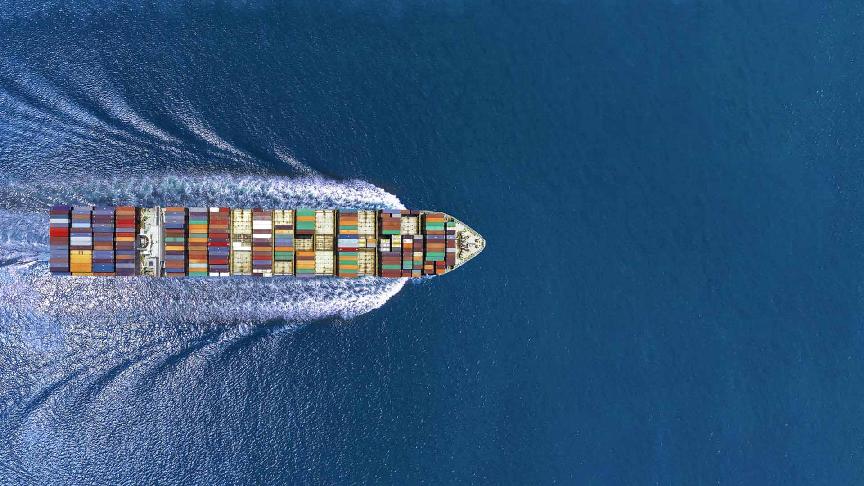The accumulative effect of ship reroutings due to Houthi attacks in the Red Sea is causing a capacity crunch in ocean freight. With this report, Kuehne+Nagel provides an overview of how this occurred and how it impacts container carriers and shippers.
Leading shipping lines, such as CMA CGM and Hapag-Lloyd, have recently reported growth in shipped volumes after a somewhat challenging year for containerised trade after the pandemic. On the other hand, the shipping industry is witnessing a new unprecedented challenge that has created a disruptive and volatile market environment.
After the Houthi attacks started in late 2023 against all types of ships passing the Gulf of Aden and the Red Sea, liners had to change course.
The extended shipping times caused by the longer route taken by vessels around Africa instead of transiting the Suez Canal left the shipping industry grappling with a shortage of containers.
With time, this caused a capacity crunch, a term that best describes a situation of tight ocean capacity.

What causes a capacity crunch in container shipping?
In shipping, a capacity crunch occurs when container carriers are unable to deploy enough vessels, slots on vessels, or container equipment to meet shippers' demands.
Multiple factors contribute to a capacity crunch; the current shipping scene has brought many of them together.
Geographically, the route through the Suez Canal provides the shortest link between Europe and Asia. Since December 2023, vessels have been taking the longer route around the Cape of Good Hope, increasing shipping times and causing containers to arrive later than usual.
Containers arriving with this time extension in Asian ports multiply the shortage. As demand rises, carriers struggle to meet the requirements due to delayed shipments.
Bad weather conditions in Asia, Africa, and even Europe add to the problem. Weather-related operational disruptions at ports slowed the availability of empty containers in China, Malaysia, and Singapore.
As the cycle continues, the shortage becomes more critical, affecting some shippers' supply chains and inventory management. Although the production of new containers surged to 520,000 TEU in April alone, factory productions are fully booked until the end of July.

How are container carriers reacting to the situation?
Carriers are having difficulty finding sufficient tonnage to meet the growing demand. The extended route requires more vessels, but deploying additional ships isn't always feasible. Other options include buying or chartering more containers or ordering ships to sail faster.
Danish container line Maersk highlighted the complexity of the situation in the Red Sea in an advisory last week, saying it has "intensified in recent months."
To keep up, Maersk decided to lease more than 125,000 additional containers and increase the sailing speeds for some vessels. These solutions inevitably increased expenses and shipping costs.
In addition, the capacity crunch would impact carriers' ability to keep weekly sailing schedules.
Carriers sometimes resort to blank sailings to maintain timely arrivals and departures. This includes skipping specific port calls to keep on-time performance on track. While it helps manage schedules, it could exacerbate the container shortage in blanked locations.
According to shipping experts at Drewry, 17 sailings were cancelled on the Transpacific route between calendar weeks 20 and 24. Blank sailings data shows a significant 10% reduction in capacity initially allocated for May shipments to the US East and West Coasts.
Furthermore, carriers resort to increasing vessel speeds to maintain punctual arrivals. Longer routes and higher speeds require more fuel consumption, increasing a ship's CO2 emission.
According to a report by Reuters, when a large container ship travels from Shanghai to Hamburg, it produces 38% more carbon dioxide (equivalent to 4.32 million kilograms) if it takes the longer route around Africa instead of going through the Suez Canal.
How does a capacity crunch impact shippers?
Besides increased freight rates, the apparent issues a capacity crunch brings are shipment delays and uncertainty.
In such a dynamic environment, it is important to prioritise flexibility and adaptability to facilitate effective navigation of changing conditions. As consumer demand recovers, businesses tend to take a flexible pricing approach in order to access limited shipping capacity.
Moreover, strategic planning and order prioritisation are essential. Shippers are advised to prioritise critical shipments to maintain resources and the ability to swiftly fulfil customers' demands.
Speaking to the Financial Times, Michael Aldwell, Kuehne+Nagel's Executive Vice President Sea Logistics, highlighted that the peak season has been brought forward, and customers pre-booked shipments for the festive period as early as April.
Last but not least, staying informed about the changes is also important as the peak season nears. It helps shippers recognise which trade lanes are currently affected and assist their planning process.







